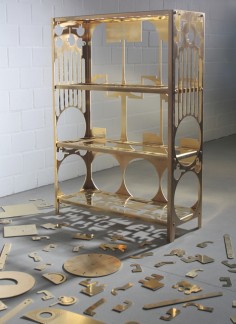Samuel Treindl
Parasite Production

source: dezeen
Samuel Treindl from Münster in Germany used what he called a “parasite strategy” to create new products from existing furniture items and intends for the final pieces to reflect the manufacturing process.
In the collection – called Parasite Production – Treindl created a clock from material cut from a peach cabinet and a desk lamp from shapes cut out of an Ikea PS cabinet.
More recently the designer cut a range of components such as a hooks and hinges from a brass book shelf.
His process means that the original cabinets can still be used. “In order to work in a more economic way, I superimpose different objects on a single metal sheet,” said Treindl. “So the same material would be used twice.”
All of the objects have been produced in Germany as limited editions. Triendl’s work will be exhibited at London’s Mint Shop during London Design Festival next month.
Parasite Production was first shown as a prototype at the SaloneSatellite showcase for young designers at the Salone Internazionale del Mobile in Milan in April, that also featured squishy lamps made out of rubber by Thomas Schnur.
This work is based on a parasitic strategy. The cabinets and other products are produced simultaneously. The results therefore reflect the manufacturing process and history of the production.
As a producer and designer I have to pay attention to the manufacturing of a product, but also to offcuts and loss of material.
In order to work in a more economic way, I superimpose different objects on a single metal sheet. So the same material would be double used. And the question is, where is here the rest? According to which other objects are currently produced, the obtained ornaments as well as the thickness of the material of the shelf can differ.
Example: If an industrial company produces spoons and forks, I will make a spoon shelf. If lamps are produced, I make a lamp cabinet. That way, I don’t want to design furniture, but I create a process which uses industrial production for generating and designing objects.
.
.
.
.
.
.
.
source: bloggessato
I make the most out of what we’ve got. Dinner? Let’s see…um I have a box of spaghetti, a hunk of pecorino, oh and I will throw in there some fresh herbs from the garden, halve some cherry tomatoes over it…with a drizzle of olive oil, hunk of crusty bread, done. Would you look at that, I did have something to make us for dinner.
German designer Samuel Treindl has discovered a way to make the most it of the existing furniture he had, twice! Parasite Production is a series of cabinets, shelves, and other pieces of furniture that have select shapes exactly cut out to create other useful objects. The brass shelving unit receives a “wholly transformation” after many, many recycled hooks and hinges emerge. Rather than discarding of the shelf, its new look makes for the most curious art form furnishing your living room has ever met.
.
.
.
.
.
.
.
source: samuel-treindlde
Samuel Treindl lebt und arbeitet in Münster und realisiert in Zusammenarbeit mit Produzenten Produkte aus den Bereichen Leuchten, Accessoires und Wohnobjekte. In den letzten Jahren erforschte er Strategien zum Thema Ressourcen Aneignung und selbstbestimmte Produktion wie z.B. „postindustrielle Produktion“, „parasitäre Produktion“ oder „Produktion und Anarchie“.
So versteht er sich als Vermittler zwischen Kunst, Design, Handwerk und Industrie. 2010 erhielt er in ein Stipendium am Designlabor Bremerhaven im Bereich Stadtentwicklung. Seine Arbeiten wurden unter anderem durch den Interieur Innovation Award 2012 und Focus Silber 2011 ausgezeichnet. 2014 war er nominiert für den Designpreis der Bundesrepublik. Seine Arbeiten wurden auf Zahlreichen Ausstellungen und Messen präsentiert.
.
.
.
.
.
.
.
source: makocoil
המעצב הגרמני סמואל טריינדל (Samuel Treindl) אינו הראשון שמשחק עם הרהיטים של איקאה בניסיון לייצר מהם משהו פחות שבלוני, אבל לא פחות שימושי. למעשה, ברחבי הרשת אפשר למצוא שלל דוגמאות לעיצובים מחודשים לפריטים של ענקית הרהיטים השוודית. עם זאת, חייבים להודות, שהאופן שבו טריינדל עושה את זה, הופך את הריהוט המשוכפל של איקאה, לפריט חד פעמי בעל אופי ייחודי.
המעצב הדני ניקולאי הנסן (Nicholai Wiig Hansen), למשל, שתיכנן עבור איקאה את ה-PS Locker האדום ב-1998, ודאי לא תיאר לעצמו שיום אחד מישהו יחתוך חלקים מהארונית שלו, ויהפוך אותם לאביזרים ביתיים מעוצבים, כמו מנורת קריאה, קערה או שעון קיר. אבל טריינדל לא רק עשה זאת, אלא גם הותיר את עקבותיו בלי להתבייש.
טריינדל מכנה את הגישה שלו “פרזיטית”, קרי – יצירה שנשענת על קיומה של יצירה אחרת. את טכניקת העבודה שלו אפשר לתאר כך: הוא לוקח ביס מטאפורי מהרהיט, מעכל אותו ואז מייצר ממנו משהו חדש. איך הוא בוחר מאיפה לקחת ביס? ובכן, הוא חותך החוצה חתיכה שלתחושתו אינה נחוצה ביותר לרהיט, כמו הגב או אחד הצדדים, ואז יוצר ממנה פריט אחר, תואם.
אבל טריינדל לא עצר באיקאה, ואחד הפרוייקטים האחרונים שלו כלל נגיסת ביסים בספריית ספרים עשויית פליז. גם בפרויקט הזה השתמש טריינדל בטכניקת הפרזיטיות, על מנת לעשות שימוש חוזר מאובייקט אחד, ליצירת מספר אובייקטים שונים. ספריית הפליז הפכה למתלה בגדים מרהיב, ושעון קיר.
.
.
.
.
.
.
.
source: photozhulong
这一些列家具是由德国设计师Samuel Treindl设计的“寄生家具”。他从现有的家具中将时钟、茶杯垫的物品“剪”了下来。这是Samuel在德国明斯特度假时期产生的灵感,他用所谓的“寄生虫策略”,见新创造的产品从现有的家具中“剪”下来,并打算用家具所剩下的寥寥无几的“残骸”来反映制造过程。
在第一个收集——生产——成形的过程中,Treind从一个黄铜书架中“剪”出了一个时钟、一个桃子状的角板。在他的设计理念中,原柜仍然是可以使用的,但为了一个更经济的工作方式,可以将相同的材料使用两次。所有的这些家具都是限量版。Samuel Treindl的作品下个月将在伦敦展出。

